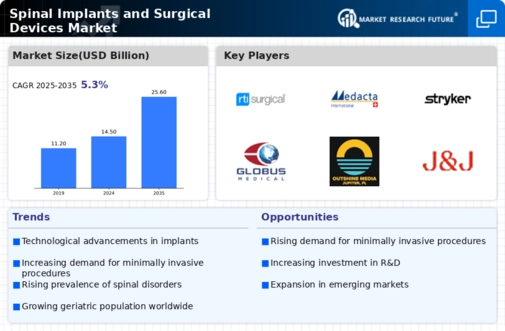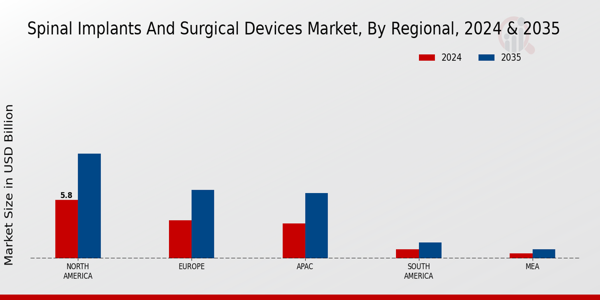Market Trends and Growth Projections
Rising Incidence of Spinal Disorders
The Global Spinal Implants and Surgical Devices Market Industry is experiencing growth due to the increasing prevalence of spinal disorders such as degenerative disc disease and scoliosis. According to health statistics, spinal disorders affect millions globally, leading to a heightened demand for surgical interventions and spinal implants. This trend is likely to drive the market, as healthcare providers seek advanced solutions to address these conditions. With the market projected to reach 14.5 USD Billion in 2024, the need for effective spinal treatments is becoming increasingly critical.
Growing Awareness and Education on Spinal Health
There is a notable increase in awareness regarding spinal health and the importance of early intervention in spinal disorders, which is positively impacting the Global Spinal Implants and Surgical Devices Market Industry. Educational campaigns and initiatives by healthcare organizations are informing the public about the risks associated with untreated spinal conditions. This heightened awareness is likely to lead to earlier diagnoses and increased demand for surgical solutions. As a result, the market is expected to flourish, driven by informed patients seeking effective treatments for their spinal issues.
Technological Advancements in Surgical Techniques
Innovations in surgical techniques and spinal implant technology are significantly influencing the Global Spinal Implants and Surgical Devices Market Industry. The introduction of minimally invasive surgical methods has improved patient outcomes and reduced recovery times, making surgeries more appealing to patients and surgeons alike. Enhanced imaging technologies and robotic-assisted surgeries are also contributing to this trend. As these technologies evolve, they are expected to drive market growth, with projections indicating a market size of 25.6 USD Billion by 2035, reflecting the ongoing demand for advanced surgical solutions.
Expansion of Distribution Channels and Global Reach
The expansion of distribution channels is playing a crucial role in the growth of the Global Spinal Implants and Surgical Devices Market Industry. With the rise of e-commerce and improved logistics, manufacturers are able to reach a broader audience, including remote and underserved areas. This increased accessibility to spinal implants and surgical devices is likely to enhance market penetration and drive sales. As companies continue to innovate in their distribution strategies, the market is poised for growth, ensuring that advanced spinal solutions are available to a wider population.
Aging Population and Increased Healthcare Expenditure
The aging population is a key driver of the Global Spinal Implants and Surgical Devices Market Industry. As individuals age, they are more susceptible to spinal disorders, necessitating surgical interventions. Furthermore, increased healthcare expenditure in many countries allows for better access to spinal surgeries and implants. This demographic shift is likely to result in a growing market, with a compound annual growth rate of 5.3% projected from 2025 to 2035. The combination of an aging population and rising healthcare investments underscores the importance of spinal health in modern healthcare.














